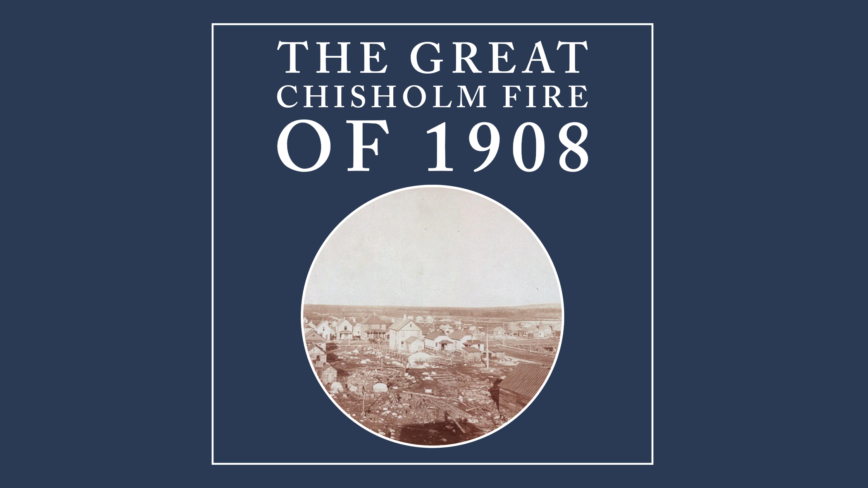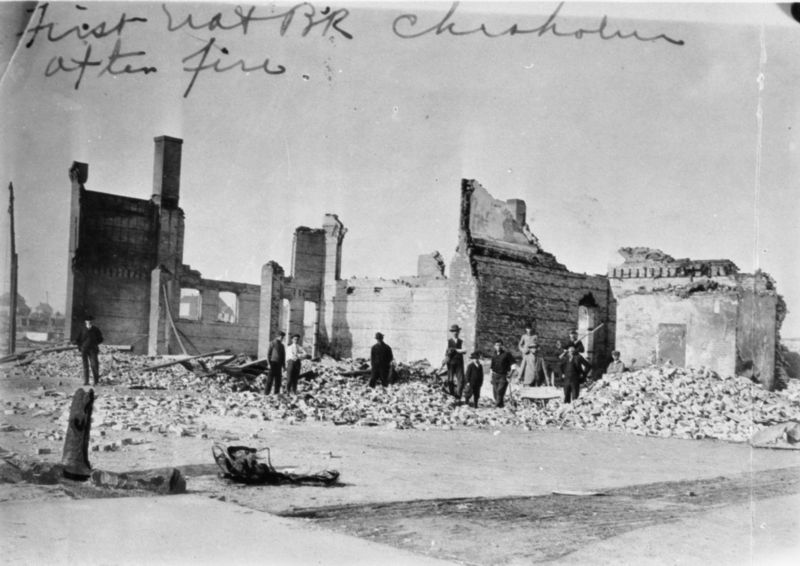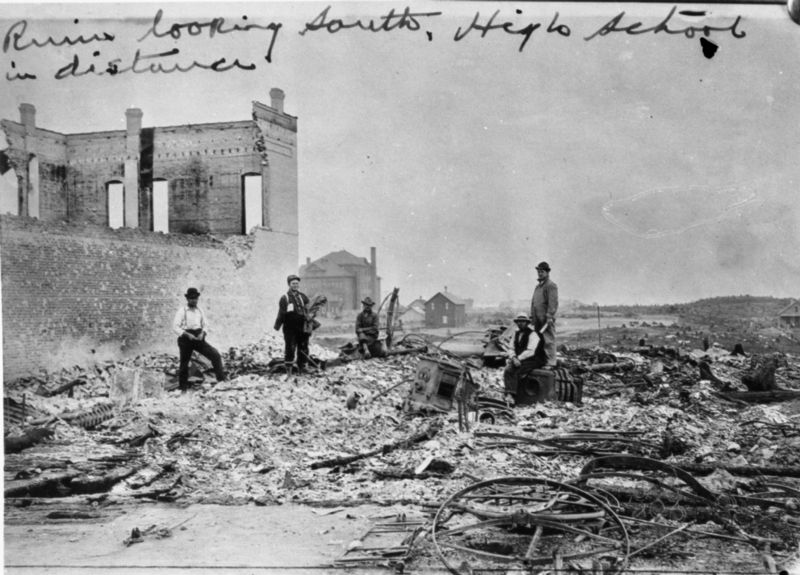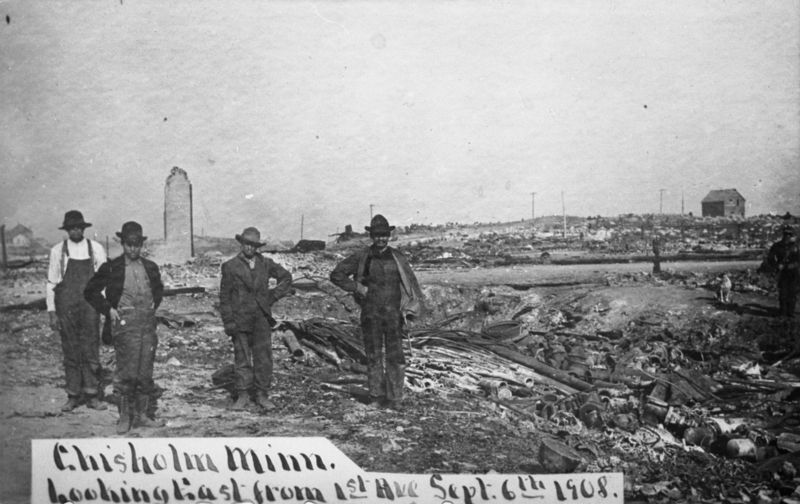
Chisholm Destroyed. — In may local periodicals, and at least one county history, will be found extensive reviews of the great fire, which almost completely gutted the business section of Chisholm, in 1908, but the following review, by Leona Train, an eleven-year-old Chisholm school girl, is worthy of inclusion in this compilation. She wrote:
“On the fifth of September, nineteen hundred eight, a little spark glowed out in the woods, four or five miles northwest of town. The dry grass and winds it on, until finally it was a large fire. The flames grew larger, and quickly burned the dry leaves and twigs. On and on they came, until they reached the town. The first few house burned, but still the fire could not be checked. The firemen worked hard, but their efforts were useless.
In the town the people rushed here and there. Some carried beds and odd pieces of furniture. In their hurry, many forgot money, jewelry, clothing, and other valuables, and only took pillows, chairs, clocks, and less important articles. A few took as much clothing as they could carry.I was so excited I jumped and up and down. Mother ran upstairs and down, snatched a few things and threw them into a suit-case. This, with our winter coats, was locked in a vault at the bank. Mother took a blanket on her arm for me, and we rushed away into the street, which was crowded with people hurrying away.
One lady, running down the street, carried a bird cage. The bottom had fallen out, and the bird had escaped, but she clung to the cage.
My cousin, Miss Chase, was staying at our house. She put on three skirts in order to save them, and left forty-five dollars in a purse on the hall radiator. We saw one lady carrying three puppies, while two babies were crying at her feet.
The smoke was so dense that one could hardly see, and the wind nearly took us off our feet.
On Lake Street there was the wildest confusion. People were hurrying about, some scantily clothed, many without coats. We went to the High School, the only brick building in Chisholm at that time. From there we could see the flames destroying the town. I can remember it well, though it has been seven years since. It was a beautiful sight, but also a very sad one. Many people lost all their property in this fire. As the fire came nearer, we all left the schoolhouse and went to the Clark mine. Here a relief train was made up of box cars, which took us to Hibbing. When we arrived there, the people were very kind and came to meet our cars. They were very hospitable, and even strangers asked us to come to their house for the night.When the fire was almost out, we went back to our unfortunate city. Only a few house remained, my cousin’s house and our’s among them. There were but two or three business houses left.
The bank was supposed to be fireproof, but when we got back only the vault and part of the wall were standing. The vault was so hot from the fire that it could not be opened for three days. The contents were not injured.

“First National Bank in ruins after 1908 fire, Chisholm, Minnesota.” 1908. Iron Range Research Center, reflections.mndigital.org/catalog/irrc:1730 Accessed 2 Sept. 2020.

“Chisholm in ruins to the south, with high school in background, after the 1908 fire.” 1908. Iron Range Research Center, reflections.mndigital.org/catalog/irrc:1729 Accessed 2 Sept. 2020.
Relief trains came from Duluth. The first one was loaded with provisions and blankets, and reached here about noon, the day after the fire. Neither of the school houses were burned, and here the local relief committee began to house and feed the people. Each family was given food and clothing, according to the size of the family. A great many slept and ate in the school house. The kindergarten was dining room and kitchen combined.
The men hastily built wood shacks for the people to live in until better ones could be had. I remember there was family of six living in our woodshed.

“Looking east from First Avenue, Chisholm, Minnesota.” Iron Range Research Center (https://collection.mndigital.org/catalog/irrc:1690/ : accessed 15 Jan 2024).
Soon the soldiers from the Home Guard of Hibbing arrived, to keep order in the town. Many times in the night I was awakened by the sentry calling off the hour in a loud voice, or by the stern exclamation of the picket: “Who goes there?” In the midst of it all, many seemed to take their loss cheerfully, and often laughed and joked.
One night mother and some friends were returning from school when they heard someone call out: “Halt! Who goes there?: Looking ahead they saw that the sentry had challenged an old cow, which was taking a night stroll.
After enough of the shacks had been built to accommodate all of the homeless people, the men began to rebuild the business section temporarily.Chisholm had been almost completely razed. Had it not been for the ruins of the few brick buildings, which served as landmarks, it would have been somewhat difficult to trace the sites of other buildings. Among the homes saved were those of G.L. Train, C.R. Woods, J.H. McNieven, D.C. Hacket, Edward Freeman, Leon Taylor, and John McDavid. The last-named was postmaster, and, the postoffice having been destroyed, he used his front room and porch as a postoffice, the mail box being a laundry bag, hung on the porch.
Duluth and St. Louis County, Minnesota; Their Story and People: An Authentic Narrative of the Past, with Particular Attention to the Modern Era in the Commercial, Industrial, Educational, Civic and Social Development, Volume 1. Walter Van Brunt. Jan 1921. American Historical Society.
The mail was sent to Hibbing, to be stamped and sent away.
The militia stayed for about eight weeks, and the people of the county and state contributed unstintedly to the relief fund. “

“Chisholm, Minn., Nov. 5th , taken sixty days after the fire.” Dahl, E., Dahl, E., photographer. (1908) Chisholm Minnesota United States, 1908. November 5. [Photograph] Retrieved from the Library of Congress, https://www.loc.gov/item/2007662326/. Accessed 2 Sept. 2020.